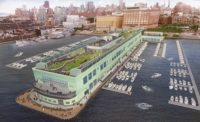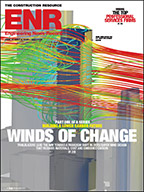...example for other states that now face delayed reauthorization of the current federal highway bill. “Other states will take note of Arizona and Nevada using GARVEE bonds to keep the project going,” says Thomas Warne, a Salt Lake City-based transportation consultant and former director of the Utah Dept. of Transportation.
The cash infusion enabled FHWA to award the contract for the main crossing. Obayashi/PSM’s bid was 15.6% above the engineer’s estimate but $12.9 million below that of Peter Kiewit Sons’ Inc., Omaha, and Flatiron Construction Corp., Longmont, Colo. Its proposed use of the cableway sparked industry interest. “Cableways aren’t a common thing to use in bridge construction,” says Khaled Mahmoud, chairman of the New York City-based Bridge Engineering Association.
But almost from the beginning, the team ran into problems. First, in early 2006, its local concrete supplier, Casino Ready Mix Inc., was found to be unlicensed, causing a 4-month delay. Then, in September 2006, 55-mile-per-hour winds caused the high lines to collapse.
Fortunately, work had stopped the day the system went down. The Nevada south tower failed, compromising adjoining tower support cables and causing them to fall in succession, like dominoes. The incident delayed construction for two years, pushing completion back to 2010. Obaysahi/PSM faces $8,000 a day in late fines after 1,271 working days, which could amount to millions in late penalties. FHWA is not ruling the incident a force majeure. The project was about 40% complete at the time.
The overall project should still finish within budget due to bids that came in 10% and 15% lower than expected, respectively, on the Nevada and Arizona approaches. Obayashi/PSM mobilized two interim cranes to continue work, while Cincinnati-based F&M Mafco Inc., with Canadian and Italian subcontractors, fabricated a replacement cableway system with “heavier components,” says Obayashi project sponsor Jim Stevens.
While the cableway system was being replaced, Obayashi/PSM mobilized a 330-ton crane on the Nevada side and a 135-ton crane on the Arizona side to build columns, pier caps, box girders, and arch segments. The new cableway system went into operation in January 2008. Replacement costs and accident details have not been disclosed because legal action is pending between American Bridge and Obayashi/PSM.
But the project’s troubles continued. On Nov. 24, 2008, ironworker Sherman Jones, 48, of Las Vegas, was killed while adjusting an alignment cable on the twin arches. Jones was untensioning a Nevada-side tower backstay using hydraulic pumps on the strand jack when the cable snapped. The U.S. Occupational Safety and Health Administration found Jones died from blunt-force trauma injuries and ruled the incident an accident. OSHA did not fine the contractor.
Officials hope the worst is over. Las Vegas Paving Corp. finished a $7-million contract for interim hot-mix asphalt surfacing in 2008. One last $8-million contract will soon go to bid for paving remaining roadway and tie-ins at U.S. 93, plus final signing and striping. The bridge now is scheduled to open in November 2010, coinciding with the 75th anniversary of the Hoover Dam.






















Post a comment to this article
Report Abusive Comment